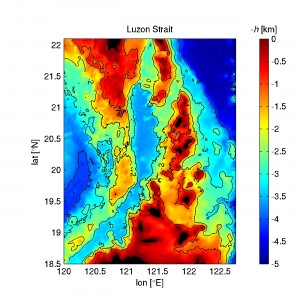By Morgan Kelly, Office of Communications

Beyond the pounding surf loved by novelists and beachgoers alike, the ocean contains rolling internal waves beneath the surface that displace massive amounts of water and push heat and vital nutrients up from the deep ocean.
Internal waves have long been recognized as essential components of the ocean’s nutrient cycle, and key to how oceans will store and distribute additional heat brought on by global warming. Yet, scientists have not until now had a thorough understanding of how internal waves start, move and dissipate.
Researchers from the Office of Naval Research’s multi-institutional Internal Waves In Straits Experiment (IWISE) have published in the journal Nature the first “cradle-to-grave” model of the world’s most powerful internal waves. Caused by the tide, the waves move through the Luzon Strait between southern Taiwan and the Philippine island of Luzon that connects the Pacific Ocean to the South China Sea.

Combining computer models constructed largely by Princeton University researchers with on-ship observations, the researchers determined the movement and energy of the waves from their origin on a double-ridge between Taiwan and the Philippines to when they fade off the coast of China. Known to provide nutrients for whales and pose a hazard to shipping, the Luzon Strait internal waves move west at speeds as fast as 3 meters (18 feet) per second and can be as much as 500 meters (1,640 feet) from trough to crest, the researchers found.
The Luzon Strait internal waves provide an ideal archetype for understanding internal waves, explained co-author Sonya Legg, a Princeton senior research oceanographer in the Program in Atmospheric and Oceanic Sciences and a lecturer in geosciences. The distance from the Luzon Strait to China is relatively short — compared to perhaps the Hawaiian internal wave that crosses the Pacific to Oregon — and the South China Sea is relatively free of obstructions such as islands, crosscurrents and eddies, Legg said. Not only did these factors make the waves much more manageable to model and study in the field, but also resulted in a clearer understanding of wave dynamics that can be used to understand internal waves elsewhere in the ocean, she said.

“We know there are these waves in other parts of the ocean, but they’re hard to look at because there are other things in the way,” Legg said. “The Luzon Strait waves are in a mini-basin, so instead of the whole Pacific to focus on, we had this small sea — it’s much more manageable. It’s a place you can think of as a laboratory in the ocean that’s much simpler than other parts of the ocean.”
Legg and co-author Maarten Buijsman, who worked on the project while a postdoctoral researcher at Princeton and is now an assistant professor of physical oceanography at the University of Southern Mississippi, created computer simulations of the Luzon Strait waves that the researchers in the South China Sea used to determine the best locations to gather data.
For instance, Legg and Buijsman used their models to pinpoint where and when the waves begin with the most energy as the ocean tide crosses westward over the strait’s two underwater ridges. Notably, their models showed that the two ridges greatly amplify the size and energy of the wave, well beyond the sum of what the two ridges would generate separately. The complexity of a two-ridge system was not previously known, Legg said.
The energy coming off the strait’s two ridges steepens as it moves toward China, evolving from a rolling wavelength to a steep “saw-tooth” pattern, Legg said. These are the kind of data the researchers sought to gather — where the energy behind internal waves goes and how it changes on its way. How an internal wave’s energy is dissipated determines the amount of heat and nutrients that are transferred from the cold depths of the lower ocean to the warm surface waters, or vice versa.
Models used to project conditions on an Earth warmed by climate change especially need to consider how the ocean will move excess heat around, Legg said. Heat that stays at the surface will ultimately result in greater sea-level rise as warmer water expands more readily as it heats up. The cold water of the deep, however, expands less for the same input of heat and has a greater capacity to store warm water. If heat goes to the deep ocean, that could greatly increase how much heat the oceans can absorb, Legg said.
As researchers learn more about internal waves such as those in the Luzon Strait, climate models can be tested against what becomes known about ocean mechanics to more accurately project conditions on a warmer Earth, she said.
“Ultimately, we want to know what effect the transportation and storage of heat has on the ocean. Internal waves are a significant piece in the puzzle in telling us where heat is stored,” Legg said. “We have in the Luzon Strait an oceanic laboratory where we can test our theoretical models and simulations to see them play out on a small scale.”
This work supported by the U.S. Office of Naval Research and the Taiwan National Science Council.
Matthew H. Alford, et al. 2015. The formation and fate of internal waves in the South China Sea. Nature. Article published online in-advance-of-print May 7, 2015. DOI: 10.1038/nature14399

You must be logged in to post a comment.